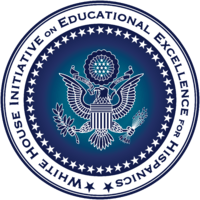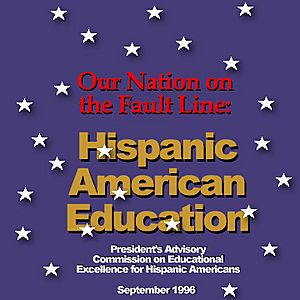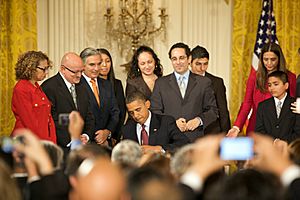White House Initiative on Educational Excellence for Hispanics facts for kids
 |
|
Quick facts for kids Agency overview |
|
|---|---|
| Formed | September 24, 1990 |
| Agency executives |
|
| Parent agency | US Department of Education |
| Website | ED.gov/HispanicInitiative |
The White House Initiative on Educational Excellence for Hispanics is a special group within the Department of Education. Its main job is to help make sure that Hispanic American students get a great education. It also works to create more chances for them to join federal education programs. This group helps close the gap in how well Hispanic American students do in school. It also supports a special team called the President's Advisory Commission on Educational Excellence for Hispanics.
How the Initiative Works
Even though it's called a "White House Initiative," this group is actually part of the United States Department of Education. It has its own staff and funding. Its main goal is to support the President's Advisory Commission. This Commission gives advice to the Secretary of Education and, through them, to the President.
The President's Advisory Commission
The number of people on the Commission changes with each new President. It usually has between 15 and 25 members, often led by two co-chairs. These members come from many different areas, like education, sports, business, and entertainment. They are chosen because they are well-known Hispanic Americans or because they care a lot about Hispanic issues. They serve without pay. The Commission writes reports to give advice and guidance.
The Initiative's Role
The Initiative is a full office within the Education Department. It has both appointed and regular staff members, and it's led by an Executive Director. The Director is chosen by the President or the Secretary of Education. When a new President takes office, the Initiative's main mission might change, but the office doesn't completely close. A small team stays on, waiting for a new plan or until staff members get new jobs.
A Look Back: The Initiative's History
Starting with President George H. W. Bush
The Commission and Initiative first began during President George H. W. Bush's time in office. This was part of his "America 2000 Education Strategy." For about two years, Hispanic groups and leaders had asked the government for a federal agency to help with education for Hispanic Americans. They wanted to improve academic results.
After much discussion, President Bush signed Executive Order 12729 on September 24, 1990. This order created the first Commission and the Initiative. The Commission's goal was to advise the Secretary of Education on how Hispanic Americans were doing with national education goals. It also looked at other important parts of their education. The Commission was asked to focus on:
- Helping parents get more involved.
- Supporting early childhood education.
- Removing things that stop students from succeeding, especially if they don't speak English well.
- Helping students reach their full potential at all school levels.
- Getting more private companies and communities involved in improving education.
However, there were some problems at first. The first Initiative director resigned quickly. Then, the Secretary of Education, Lauro Cavazos, left his job. This slowed things down for a year. Finally, in September 1991, the first 17 Commission members were sworn in. The Initiative also got a full staff and a new Executive Director, John Florez.
Important people on this first Commission included Raul Yzaguirre, Diana Natalicio (the first female president of the University of Texas at El Paso), businessman Peter H. Coors, and golfer Nancy Lopez.
The Commission released its only report on October 12, 1992. It was called A Progress Report to the Secretary of Education from the President's Advisory Commission on Educational Excellence for Hispanic Americans.
Under President Bill Clinton
President Bill Clinton restarted the Commission on February 18, 1994, with Executive Order 12900. This new Commission also advised the President through the Secretary of Education. Its goals were a bit different:
- Report on how Hispanic Americans were doing with national education goals.
- Watch over and coordinate federal efforts to give Hispanic Americans high-quality education.
- Find ways to increase involvement from states, private companies, and communities in improving education.
- Find ways to expand and add to federal education plans.
Again, other political issues delayed the Commission's work for almost a year. On February 1, 1995, 24 members of the Commission were sworn in. Notable members included educators Guillermo Linares and Eduardo J. Padrón, writer John Phillip Santos, businesspeople Linda G. Alvarado and Martin J. Koldyke, and Raul Yzaguirre, who was the chairman.
Within a year, the chairman, Yzaguirre, said the Commission wasn't working well. He felt it was stuck in "bureaucratic problems and politics" and that the Initiative's staff wasn't giving enough support. He was especially upset that their first report was almost a year late. The Clinton Administration thanked him and said the report would be ready soon. It was finally released in September, called Our Nation on the Fault Line: Hispanic American Education.
A new Executive Director, Sarita Brown, was named in 1997. She was praised for making the Initiative stronger and focusing more on funding for Hispanic education. On September 25, 2000, the Commission, now led by Linares, released its second report: Creating the Will: Hispanics Achieving Educational Excellence.
During President George W. Bush's Time
George W. Bush created his President's Advisory Commission on October 12, 2001, with Executive Order 13230. The Commission's job was updated to give advice and write reports to:
- Track how Hispanic Americans were doing in closing the education gap and reaching goals from the President's "No Child Left Behind" plan.
- Develop, watch, and coordinate federal efforts to promote good education for Hispanic Americans.
- Find ways to get more parents, states, local groups, private companies, and communities involved in improving education.
- Find ways to make federal education efforts as effective as possible.
The Commission had 20 members and met for the first time in February 2002. Some well-known members were educator Alexander Gonzalez, judge Micaela Alvarez, businessmen Charles P. Garcia and Frank Hanna III, astronaut Fernando Caldeiro, teacher Jaime Escalante, and singer Jon Secada. Also, important government officials like US Treasurer Rosario Marin were part of the Commission.
During this time, the Commission released two reports. The first, The Road to a College Diploma: The Complex Reality of Raising Educational Achievement for Hispanics in the United States, came out on September 30, 2002. It shared early findings on Hispanic education in the U.S. The second report, From Risk to Opportunity: Fulfilling the Educational Needs of Hispanic Americans in the 21st Century, was released on March 31, 2003. It gave six ideas to help Hispanic students do better in school.
From June 16 to June 17, 2005, the Initiative held a conference called Pathways to Hispanic Family Learning. This meeting led to a new program, the Partnership for Hispanic Family Learning. This program connected public and private groups that help Hispanic families prepare their children for school success. Information and resources were then shared through regional meetings.
In 2007, the Initiative held a conference with the American Competitiveness Initiative (ACI). It was called The American Competitiveness Initiative: Challenges and Opportunities for Hispanic Serving Institutions. After this meeting, a joint group was formed to help colleges that serve many Hispanic students.
The Obama Administration's Efforts
In July 2009, the Barack Obama Administration started holding meetings to get ideas on what Hispanic communities needed for education. President Obama set a new goal: by 2020, America would have the most college graduates in the world. On October 19, 2010, President Obama signed Executive Order 13555. This order renewed the White House Initiative on Educational Excellence for Hispanics. Its mission was to help the U.S. become a world leader in education again. It also aimed to give more educational chances to Hispanics of all ages. The goal was to help all Hispanics get a complete education that prepares them for college, jobs, and happy lives.
President Obama said, "Our country was built on and continues to thrive on its diversity, and there is no doubt that the future of the United States is inextricably linked to the future of the Hispanic community." He also appointed a new commission, led by Eduardo J. Padrón. Famous singer Shakira was also a member.
In September 2011, the White House released a report on Latino education called "Winning the Future: Improving Education for the Latino Community."
In October 2013, the Initiative started a monthly online meeting series. These meetings connected leaders from across the country. They also highlighted "Bright Spots"—programs, schools, or groups that were helping to close the education gap for Hispanic students. These meetings discussed programs, policies, and good practices that help the Hispanic community. Topics included:
- Early Learning
- Immigrant Integration
- Family Engagement
- Student Financial Help
- English Learners
- Improving Education for Hispanic Males
- College- and Career-Ready Standards
In December 2013, Executive Director Alejandra Ceja announced the Initiative's plan for 2013–2016. This plan aimed to involve leaders, groups, educators, families, and students in helping Hispanic students succeed. The Initiative worked to promote good early learning, show strong examples of school improvements, and encourage colleges to graduate more Latino students ready for jobs.
In May 2014, the Initiative released a guide called ¡Gradúate! A Financial Aid Guide to Success. This guide helps Hispanic students and their families understand how to apply for college. It gives tips on filling out financial aid forms and lists resources for students, including those with Deferred Action for Childhood Arrivals (DACA) status.
The Initiative also supported President Obama's My Brother's Keeper Initiative. This program helps boys and young men of color, including Hispanics, overcome challenges and reach their full potential.
The year 2015 marked 25 years since the Initiative began. To celebrate, the Initiative launched a "year of action" called "Fulfilling America's Future." This highlighted education gains and looked to the future. It also made important suggestions for leaders in different areas. As part of this celebration, the Initiative released a plan to guide education priorities for the Hispanic community.
Leaders of the Initiative
The current executive director of the White House Initiative is Melody Gonzales.
Past Directors
| No. | Name | Term of Office | President(s) served under |
|---|---|---|---|
| 1 | Col. Gilbert D. Roman | October 1990 - November 1990 | George H. W. Bush |
| 2 | John Florez | September 1991 - January 1993 | George H. W. Bush |
| 3 | Alfred Robert Ramirez | February 1994 - July 1997 | Bill Clinton |
| 4 | Sarita E. Brown | August 1997 - December 2000 | Bill Clinton |
| 5 | Leslie Sanchez | May 2001 - June 2003 | George W. Bush |
| - | Maria Hernandez Ferrier (acting) | June 2003 - December 2003 | George W. Bush |
| 6 | Adam Chavarria | December 2003 - January 2009 | George W. Bush |
| 7 | Juan Sepúlveda | May 2009 – December 2011 | Barack Obama |
| 8 | Jose Rico | December 2011 – December 2012 | Barack Obama |
| 9 | Marco Davis (acting) | December 2012 – May 2013 | Barack Obama |
| 10 | Alejandra Ceja | May 2013 – January 2021 | Barack Obama, Donald Trump |
| 11 | Melody Gonzales | December 2021 – Present | Joe Biden |



